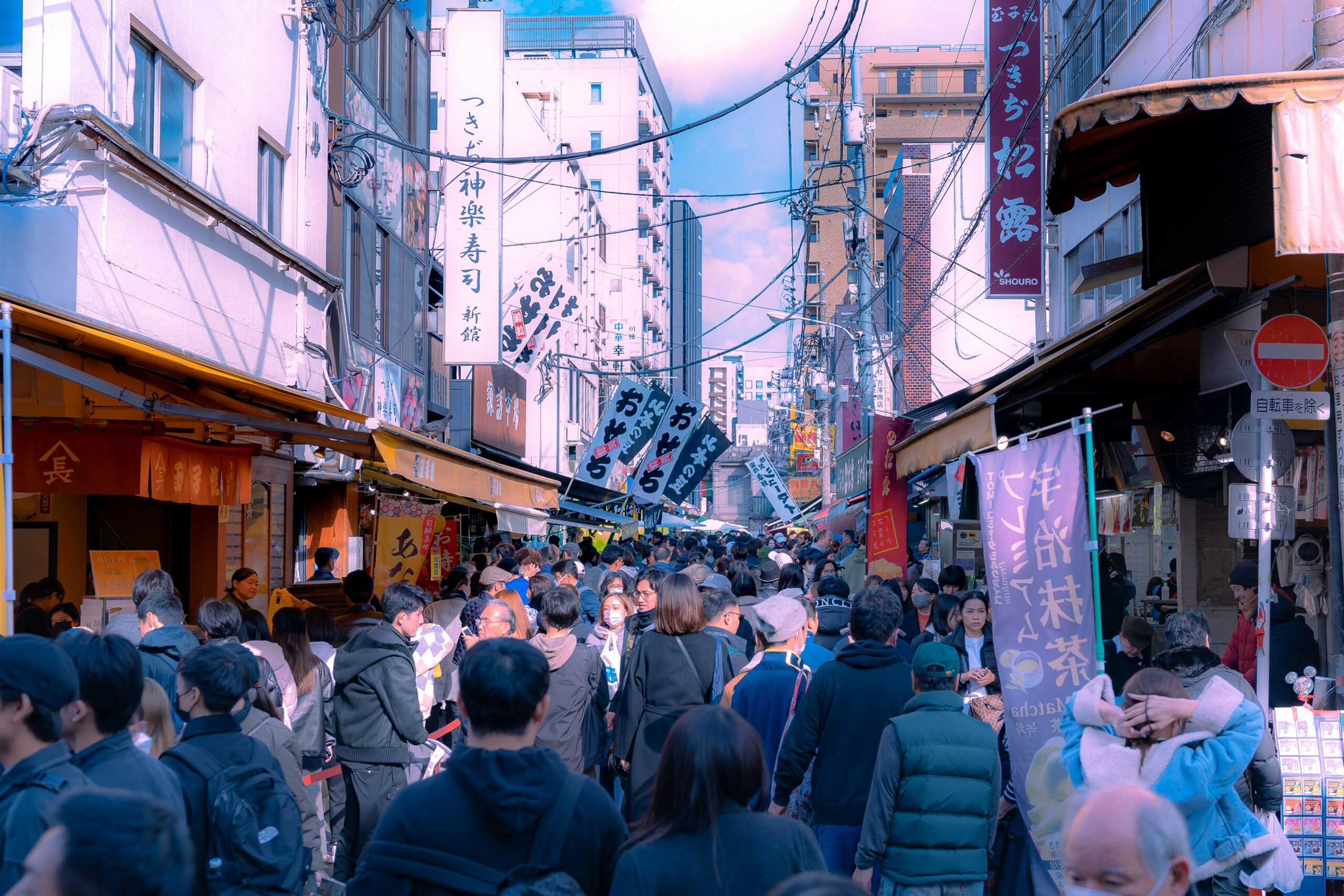Ana Miller, a 32-year-old logistics professional from New Zealand, had built a solid career and a stable life. From the outside, everything seemed to be going well. But in recent years, she had begun to feel a quiet unease—like her life had settled into a rhythm that no longer moved her. It wasn’t burnout, nor dissatisfaction exactly. It was as if, in the comfort of the familiar, something essential was slowly going quiet.
Then came a work assignment in Tokyo. Between meetings and reports, a rare open morning appeared in her schedule. Sitting in her hotel room, she overheard the name “Tsukiji” on the television. The name rang out with an unexpected clarity, stirring something inside her. She looked it up. Once the site of the world’s largest fish market, Tsukiji still thrived as an outer market filled with stalls, food, and the rhythm of everyday life. She decided to go—not to chase some perfect image of Tokyo, but to feel something real.
8:00 AM
Exiting Tsukiji Station, Ana was greeted by the early summer air—soft, damp, touched by the sea. The sky above was a gentle wash of pale blue. She made her way first to Namiyoke Shrine, a small Shinto sanctuary nestled between buildings. Though modest in size, it held a quiet weight. At its entrance stood a pair of weatherworn lion-dog statues, gazing toward the ocean as if guarding against unseen storms.
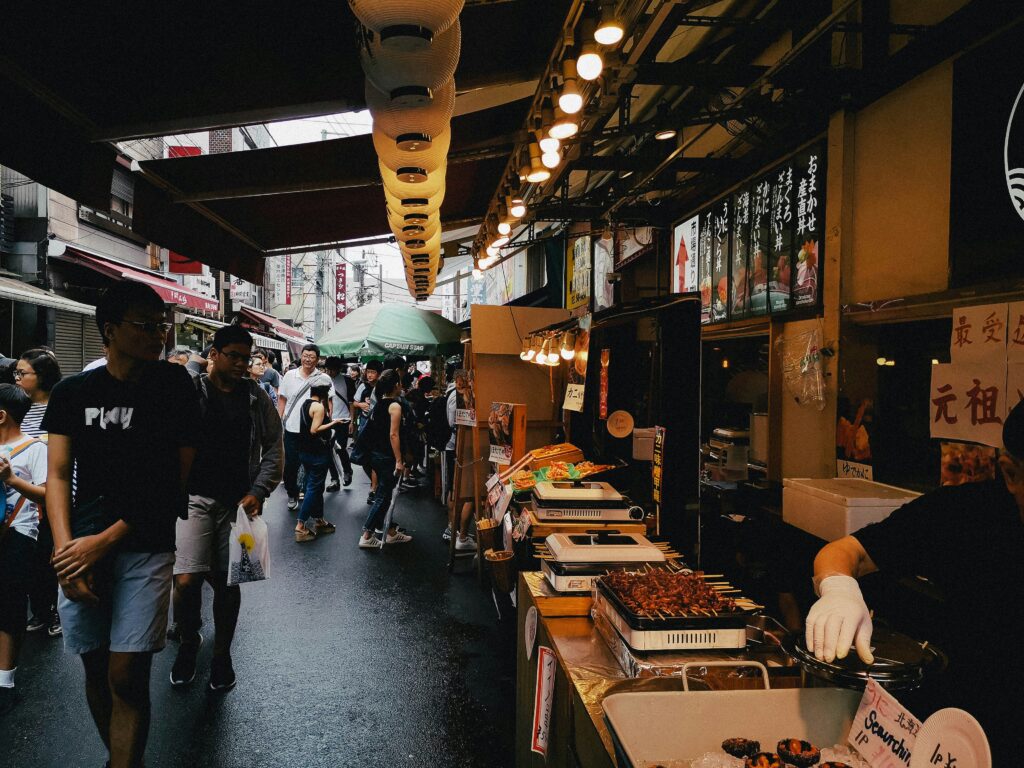
Reading the signs, Ana learned that the shrine had been built to calm the sea and protect the workers of the market. In this small, salt-scented space, she sensed a Tokyo far older and deeper than the one of glass towers and neon signs. A Tokyo born from tides, toil, and trust in unseen forces.
The Market Awakens
Stepping into the outer market was like entering another world.
Shouts echoed between narrow lanes. Vendors called out prices, jokes, greetings. The scent of grilled fish mingled with the sharp aroma of fresh wasabi. Tuna glistened on wooden trays, clams bubbled in tanks, and skewers of unagi sizzled over charcoal. Ana’s senses—sight, sound, smell, taste, and touch—were instantly alive, pulled into the present moment.
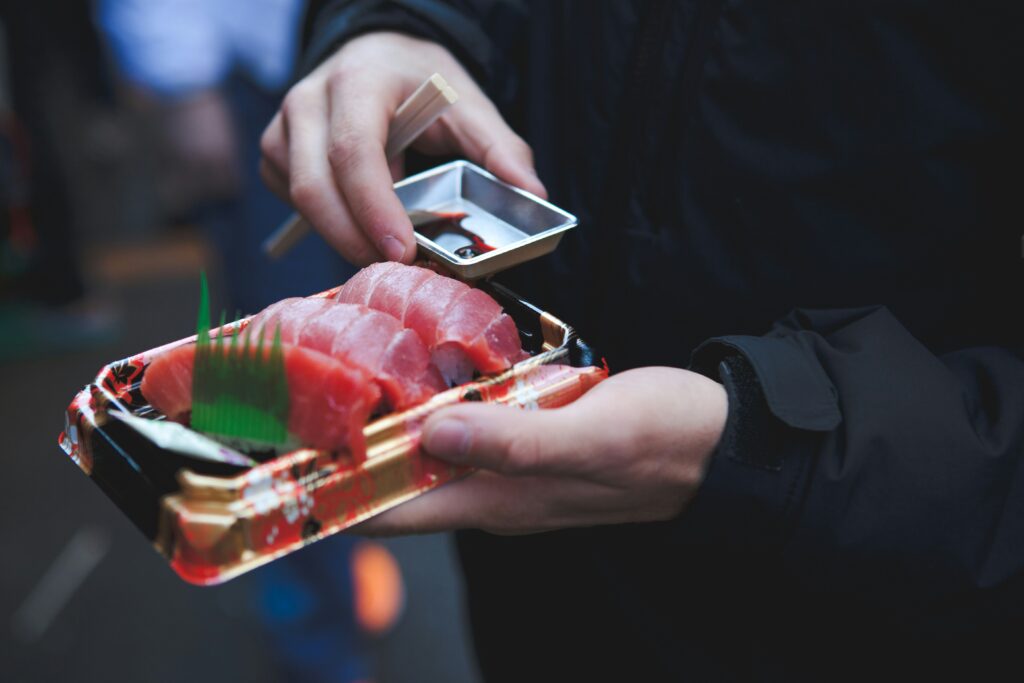
She was drawn to a tiny stand-up sushi shop. The wooden sign was understated, the noren curtain gently swaying. Through the slatted bamboo, she glimpsed the graceful hands of the sushi chefs, each movement purposeful. Without thinking too much, she stepped inside.
Piece by piece, sushi was placed before her. She paused at the chu-toro—medium fatty tuna. The moment it touched her tongue, it melted—creamy, rich, with just a whisper of vinegar from the rice. Her eyes closed, not from habit, but reverence. It wasn’t just food—it was a kind of memory made real.
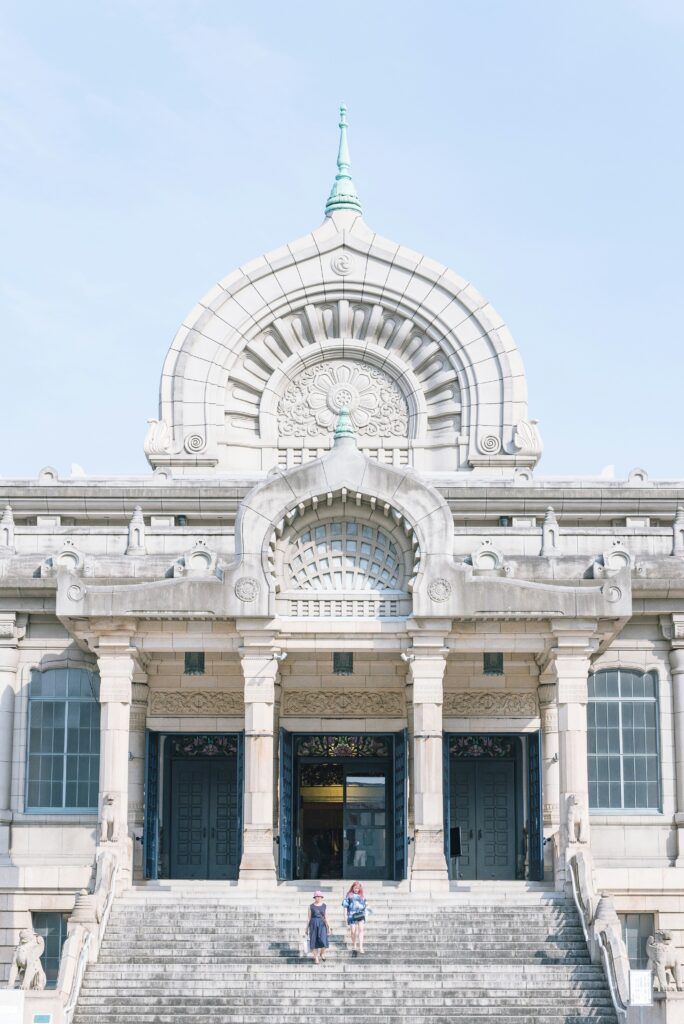
Where East Meets Everywhere
Later, Ana walked to Tsukiji Hongwanji, a temple unlike any she had seen before. Its grand stone façade looked more like an ancient Indian palace than a Buddhist sanctuary in Tokyo. Designed in the early 20th century, the temple blended classical Indian motifs with Western architectural principles, creating a kind of hybrid beauty.
Inside, the air was cool and still. She sat quietly, allowing her breath to settle. Why had she come to Tokyo, really? What was she searching for beneath the polite reason of “work”?
Perhaps she had come to remember that the world was wide—and that she still longed to meet it with open arms.
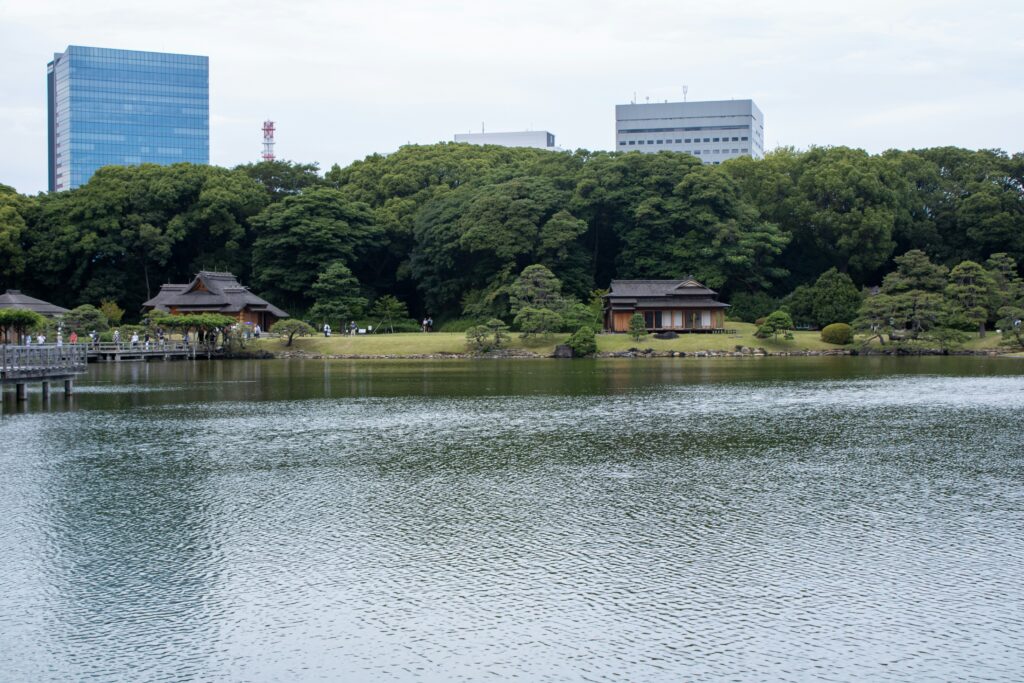
An Unexpected Garden
By early afternoon, Ana found herself walking to Hamarikyu Gardens, just ten minutes from the market. As she stepped inside, the city fell away. Towering pines lined stone paths. A calm pond mirrored the sky. This was once a feudal lord’s garden, she learned, where saltwater from Tokyo Bay flowed in and out with the tide.
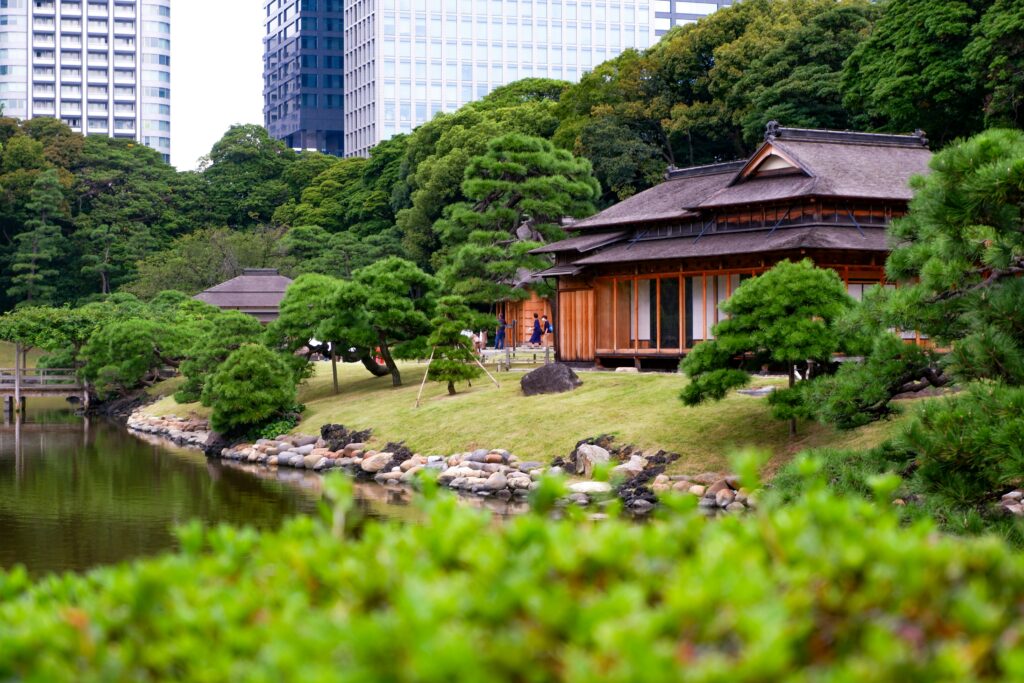
She wandered among the green, pausing near a tea house built over the water. Inside, she ordered matcha and a seasonal sweet.
The matcha was thick and slightly bitter, while the accompanying wagashi—a delicately crafted nerikiri—resembled a blooming hydrangea. It melted in her mouth, sweet and ephemeral. In that moment, she tasted the season itself.
A Quiet Conversation
Curious to return to the market’s streets before sunset, Ana meandered back and, turning down a narrow side alley, discovered a small café. A white noren hung over the doorway, and a simple wooden sign read: Kissa Mizu. She stepped inside.
There were only a few seats—a tiny counter, and two small tables. Behind the bar stood a young woman, wiping a cup clean.
“What’s your recommendation?” Ana asked in Japanese.
The woman smiled. “Today? I’d say the house-made black sesame pudding.”
Ana ordered it. The pudding arrived in a simple dish, smooth and glossy. One spoonful revealed a depth of flavor she hadn’t expected—roasted, slightly bitter, earthy, yet comforting.
The two women began to chat.
The barista’s name was Mika. She had once worked for a top advertising agency, she explained, until one day, she stopped. “I liked the work,” she said, “but my heart wasn’t keeping up.”
She placed the cup on the counter gently. “Now, even if it’s just one person, if I can make someone’s day better with a cup of coffee… it feels like I’m doing something real.”
Ana was quiet for a moment. Mika’s words stayed with her.
In her own life, Ana had been chasing results—deadlines, metrics, efficiency. But had she been listening to what truly mattered?
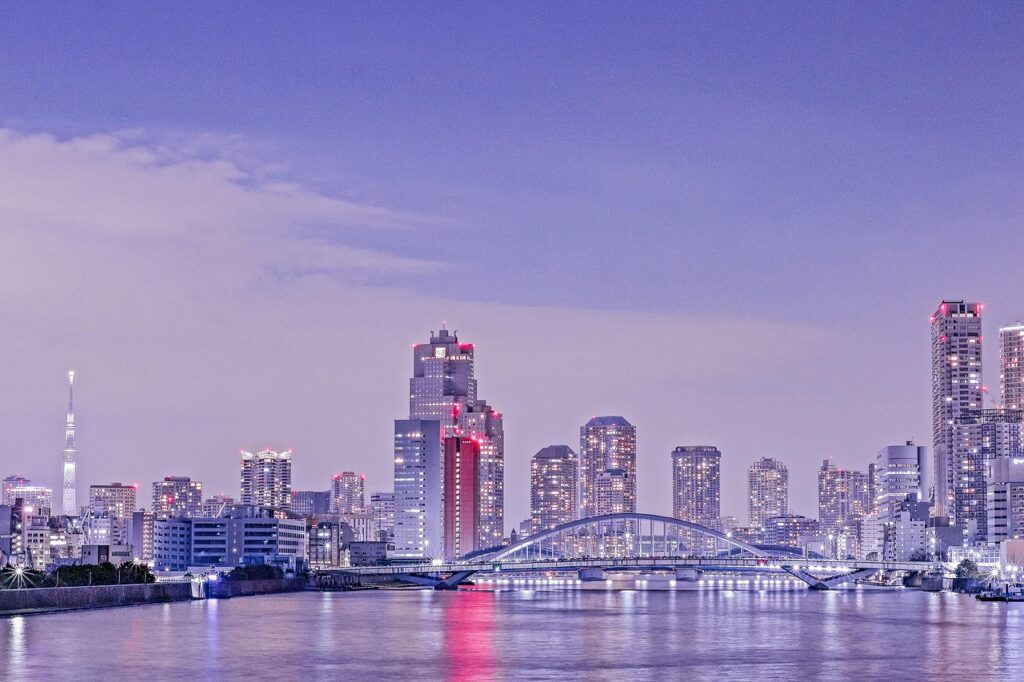
Evening Falls Over the River
As the sky turned amber, Ana walked toward the Kachidoki Bridge. Once a bascule bridge that opened to let ships pass, it now stood still—solid, silent, timeless. She crossed it slowly, the Sumida River glittering below. On the other side, the skyline shimmered in the deepening light, buildings glowing against the orange-pink dusk.
She stood there, watching the water carry the day’s light out to sea.
In just one day, she had encountered the unrelenting pulse of a market, the quiet strength of a shrine, the beauty of food, the resilience of a woman who had rewritten her own story.
She had come to Tokyo not for answers, but for a reminder—that life, in all its mess and motion, was still happening now. That being “alive” wasn’t about control or comfort. It was about presence. About listening. About daring to pause.
The streets of Tsukiji had rekindled something in her—not a roaring fire, but a steady flame.
A warmth that said:
It’s okay to change. It’s okay to not know. It’s okay to begin again.
And perhaps, in this great, tangled, tender city, she already had.
Something New Travel

